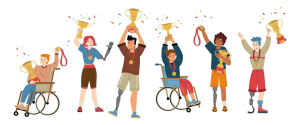Human willpower at the Paralympic Games demonstrates the capability of transforming limitations through athletic performance. The elite disabled athletes who participate fight through physical disabilities that include limb loss, combined with sight impairments and spinal injuries, to establish new, impossible benchmarks.
Origins of the Paralympics
Ludwig Guttmann, who was a German-British neurologist, organized a small archery competition exclusively for veterans who experienced spinal cord disabilities during the 1948 Olympic Games, while the world watched internationally. Athletes participating in wheelchair chairs displayed dignity through their powerful athletic ability. The same spirit of endurance continued into the present day through worldwide championship arenas and passionate online betting site in India, with fans who show equal dedication to para-sports events on digital platforms. The London event started something new.
The Paralympics became official in 1960, when Rome became the first city to host the inaugural Games. Over 400 athletes from 23 nations competed. The athletes experience the same rigorous performance standards that come with elite athletics without any special treatment, but solely through determination and strength.

Unique Sports and Classifications
Most sports in Paralympic competitions differ entirely from what spectators see in traditional competitions.
- Visually impaired athletes participate in goalball since they play blindfolded with balls that contain bells and need total stadium silence to hear the ball’s noise.
- Wheelchair Rugby is nicknamed “murderball” because of its savage speed, which makes it one of the most exciting sports to play.
- Boccia is an accurate and strategic game for athletes facing the most serious physical difficulties.
- Track Athletes compete in the T54 class division, achieving speeds reaching more than 30 kilometers per hour by exclusively using their upper body strengths to propel forward with outstanding athletic ability.
All sports in the Paralympics use specific classifications, such as T42 and S11, to ensure athletes demonstrate their talent.
Individual Stories of Triumph
Statistical evaluation fails to demonstrate the true meaning behind the Paralympic competitions. Every athlete maintains their internal war, which exceeds the scores they could ever show. Users can discover genuine triumph stories on the Melbet India Instagram, alongside other media that show achievements beyond sports scoring records. These personal battles of victories occur through wounds and perspiration as winners break their silence.
Tatyana McFadden’s Journey
The world knew Tatyana McFadden as she entered life in Russia with paralysis below her waist and spent the first years of her life at an orphanage without access to a wheelchair. Her movements throughout the day depended entirely on her arms. An American woman changed everything when she adopted a child at age six. At age 15, Tatyana participated in the Athens Paralympics because she dedicated daily massive exertion to achieving this goal.
Through her 17 Paralympic medals in four Games, Tatyana McFadden established entirely new standards that exceeded winning. She successfully advocated for equal sports rights in U.S. educational facilities for students with disabilities. Through her decisive yet historical actions, she forged success through physical strength and mental heritage.

Daniel Dias’ Swimming Legacy
Brazilian Daniel Dias chose not to allow the absence of hands and feet to shape his identity. His water entrance eliminated all his physical differences from view. Swimming became his interest after he saw another Paralympian compete on television at the age of 16. After an additional four-year training period in Beijing, he successfully broke every world record.
The career of Dias reached its end with 27 Paralympic medals, 17 of those being gold medals. The source of his achievements emerged from his fanatical devotion to every minor movement during swimming. The swimming pool was far beyond Daniel’s competitive distance because it brought out dreams while destroying his doubts.
Global Impact of the Paralympics
By staging its events, the Paralympics have achieved two significant accomplishments: improving sport while transforming worldwide understanding of human ability. Every two-year cycle of Paralympic competition triggers world nations to enhance their spending on disability policy development and accessibility improvements.
Infrastructure evolves, laws are rewritten, and public attitudes shift. The 2012 London Paralympics reached more than 3.8 billion television viewers worldwide, demonstrating their status as global sporting giants. After Tokyo 2020, the Japanese government increased its financial support for disability sports programs twofold. Visual attention that results from increased public awareness results in fundamental shifts and advances.
Looking Ahead to Future Games
Modern performance will transform when artificial intelligence training and exceptional prosthetic medical equipment combine. The broadcasting industry will progress toward offering broader access to athletes, while more viewers will participate. The path toward breakthroughs has emerged as all parts of the world simultaneously focus on it for the first time in human history.
